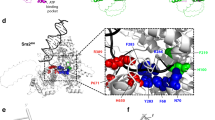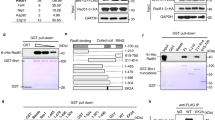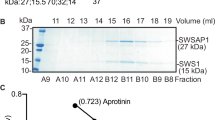Abstract
Homologous recombination is a ubiquitous process with key functions in meiotic and vegetative cells for the repair of DNA breaks. It is initiated by the formation of single-stranded DNA on which recombination proteins bind to form a nucleoprotein filament that is active in searching for homology, in the formation of joint molecules and in the exchange of DNA strands1. This process contributes to genome stability but it is also potentially dangerous to cells if intermediates are formed that cannot be processed normally and thus are toxic or generate genomic rearrangements. Cells must therefore have developed strategies to survey recombination and to prevent the occurrence of such deleterious events. In Saccharomyces cerevisiae, genetic data have shown that the Srs2 helicase negatively modulates recombination2,3, and later experiments suggested that it reverses intermediate recombination structures4,5,6,7. Here we show that DNA strand exchange mediated in vitro by Rad51 is inhibited by Srs2, and that Srs2 disrupts Rad51 filaments formed on single-stranded DNA. These data provide an explanation for the anti-recombinogenic role of Srs2 in vivo and highlight a previously unknown mechanism for recombination control.
This is a preview of subscription content, access via your institution
Access options
Subscribe to this journal
Receive 51 print issues and online access
$199.00 per year
only $3.90 per issue
Buy this article
- Purchase on SpringerLink
- Instant access to full article PDF
Prices may be subject to local taxes which are calculated during checkout



Similar content being viewed by others
References
Sung, P., Trujillo, K. M. & Van Komen, S. Recombination factors of Saccharomyces cerevisiae. Mutat. Res. 451, 257–275 (2000)
Aguilera, A. & Klein, H. L. Genetic control of intrachromosomal recombination in Saccharomyces cerevisiae. I. Isolation and genetic characterization of hyper-recombination mutations. Genetics 119, 779–790 (1988)
Aboussekhra, A. et al. RADH, a gene of Saccharomyces cerevisiae encoding a putative DNA helicase involved in DNA repair. Characteristics of radH mutants and sequence of the gene. Nucleic Acids Res. 17, 7211–7219 (1989)
Kaytor, M. D., Nguyen, M. & Livingston, D. M. The complexity of the interaction between RAD52 and SRS2. Genetics 140, 1441–1442 (1995)
Milne, G. T., Ho, T. & Weaver, D. T. Modulation of Saccharomyces cerevisiae DNA double-strand break repair by SRS2 and RAD51. Genetics 139, 1189–1199 (1995)
Schild, D. Suppression of a new allele of the yeast RAD52 gene by overexpression of RAD51, mutations in srs2 and ccr4, or mating-type heterozygosity. Genetics 140, 115–127 (1995)
Chanet, R., Heude, M., Adjiri, A., Maloisel, L. & Fabre, F. Semidominant mutations in the yeast Rad51 protein and their relationships with the Srs2 helicase. Mol. Cell. Biol. 16, 4782–4789 (1996)
Fabre, F., Chan, A., Heyer, W. D. & Gangloff, S. Alternate pathways involving Sgs1/Top3, Mus81/Mms4, and Srs2 prevent formation of toxic recombination intermediates from single-stranded gaps created by DNA replication. Proc. Natl Acad. Sci. USA 99, 1687–1692 (2002)
Klein, H. L. Mutations in recombinational repair and in checkpoint control genes suppress the lethal combination of srs2Δ with other DNA repair genes in Saccharomyces cerevisiae. Genetics 157, 557–565 (2001)
Singleton, M. R. & Wigley, D. B. Modularity and specialization in superfamily 1 and 2 helicases. J. Bacteriol. 184, 1819–1826 (2002)
Rong, L. & Klein, H. L. Purification and characterization of the Srs2 DNA helicase of the yeast Saccharomyces cerevisiae. J. Biol. Chem. 268, 1252–1259 (1993)
Petukhova, G., Stratton, S. & Sung, P. Catalysis of homologous DNA pairing by yeast Rad51 and Rad54 proteins. Nature 393, 91–94 (1998)
Krejci, L. et al. DNA helicase Srs2 disrupts formation of the Rad51 presynaptic filament. Nature 423, 305–309 (2003)
Aboussekhra, A., Chanet, R., Adjiri, A. & Fabre, F. Semidominant suppressors of Srs2 helicase mutations of Saccharomyces cerevisiae map in the RAD51 gene, whose sequence predicts a protein with similarities to procaryotic RecA proteins. Mol. Cell. Biol. 12, 3224–3234 (1992)
Lovett, S. T. & Mortimer, R. K. Characterization of null mutants of the RAD55 gene of Saccharomyces cerevisiae: effects of temperature, osmotic strength and mating type. Genetics 116, 547–553 (1987)
Vaze, M. et al. Recovery from checkpoint-mediated arrest after repair of a double-strand break requires Srs2 helicase. Mol. Cell 10, 373 (2002)
Palladino, F. & Klein, H. L. Analysis of mitotic and meiotic defects in Saccharomyces cerevisiae SRS2 DNA helicase mutants. Genetics 132, 23–37 (1992)
Heude, M., Chanet, R. & Fabre, F. Regulation of the Saccharomyces cerevisiae Srs2 helicase during the mitotic cell cycle, meiosis and after irradiation. Mol. Gen. Genet. 248, 59–68 (1995)
Van Komen, S., Petukhova, G., Sigurdsson, S., Stratton, S. & Sung, P. Superhelicity-driven homologous DNA pairing by yeast recombination factors Rad51 and Rad54. Mol. Cell 6, 563–572 (2000)
Gangloff, S., Soustelle, C. & Fabre, F. Homologous recombination is responsible for cell death in the absence of the Sgs1 and Srs2 helicases. Nature Genet. 25, 192–194 (2000)
van Brabant, A. J., Stan, R. & Ellis, N. A. DNA helicases, genomic instability, and human genetic disease. Annu. Rev. Genomics Hum. Genet. 1, 409–459 (2000)
Saintigny, Y., Makienko, K., Swanson, C., Emond, M. J. & Monnat, R. J. Jr Homologous recombination resolution defect in Werner syndrome. Mol. Cell. Biol. 22, 6971–6978 (2002)
Iggo, R. D. & Lane, D. P. Nuclear protein p68 is an RNA-dependent ATPase. EMBO J. 8, 1827–1831 (1989)
Beloin, C. et al. Contribution of DNA conformation and topology in right-handed DNA wrapping by the Bacillus subtilis LrpC protein. J. Biol. Chem. 278, 5333–5342 (2003)
Acknowledgements
We thank L. Miccoli, D. Biard and J. Angulo for advice on recombinant baculovirus preparation and protein purification. P. Bertrand and C. Auvin for confirming the identity of Srs2 by MALDI–TOF mass spectrometry, and S. Gangloff, N. Kantake, L. Leloup, L. Maloisel, J. New and T. Robert for comments and discussions. This work was supported by the Commissariat à l'Energie Atomique, the Centre National de la Recherche Scientifique and Électricité de France.
Author information
Authors and Affiliations
Corresponding authors
Ethics declarations
Competing interests
The authors declare that they have no competing financial interests.
Rights and permissions
About this article
Cite this article
Veaute, X., Jeusset, J., Soustelle, C. et al. The Srs2 helicase prevents recombination by disrupting Rad51 nucleoprotein filaments. Nature 423, 309–312 (2003). https://doi.org/10.1038/nature01585
Received:
Accepted:
Issue Date:
DOI: https://doi.org/10.1038/nature01585
This article is cited by
-
Bre1/RNF20 promotes Rad51-mediated strand exchange and antagonizes the Srs2/FBH1 helicases
Nature Communications (2023)
-
Repair of DNA double-strand breaks in plant meiosis: role of eukaryotic RecA recombinases and their modulators
Plant Reproduction (2023)
-
The inner side of yeast PCNA contributes to genome stability by mediating interactions with Rad18 and the replicative DNA polymerase δ
Scientific Reports (2022)
-
Nucleotide proofreading functions by nematode RAD51 paralogs facilitate optimal RAD51 filament function
Nature Communications (2021)
-
Single-strand template repair: key insights to increase the efficiency of gene editing
Current Genetics (2021)



